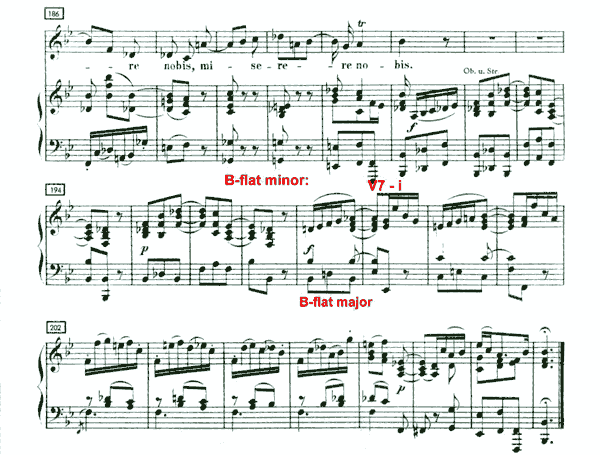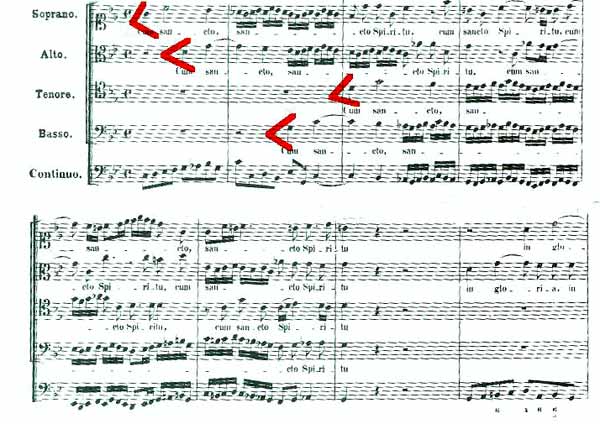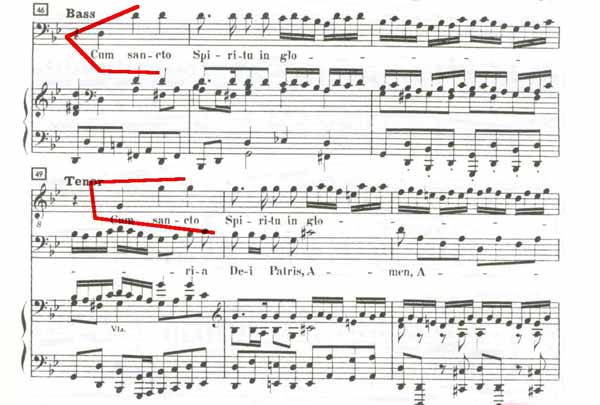Like the other Lutheran Masses, the Mass in G minor is largely derived from Bach’s earlier cantatas.
- The Kyrie is derived from BWV 102
- The first movement of the Gloria (“Gloria in excelsis Deo”) is taken from Cantata 79 (the first movement)
- The remaining movements of the Gloria (“Gratias agimus tibi”, “Domini Fili”, “Qui tollis peccata mundi”, and “Cum Sancto Spiritu”) come from Cantata 187, although the order of the music is changed here (movement 4, 3, 5, and 1 of BWV 187 correspond with movements 3, 4, 5, and 6 of the Mass in G Minor). (Robin Leaver, “The mature vocal works and their theological and liturgical context,” Chapter 7 of The Cambridge Companion to Bach, p. 115).
In this sense, the Mass in G minor may be seen as a more coherent, unified work than the Mass in G Major, which uses more works for is source material.
As in the Mass in G Major, BWV 236, the interior movements of the “Gloria” of the Mass in G minor, BWV 235, are a succession of arias for various solo voices – in this case, bass, alto, and tenor. The opening and closing movements of the “Gloira” employ the full choral and orchestral forces of the Mass in G minor. There are other parallels between these two Lutheran Masses – accidental, perhaps, given their origins in previous works; or perhaps Bach found a certain “formula” that he liked, and decided to comb his own previous works to find source material which would allow him to create a “new” work in a similar, comfortable format. What such parallels are there?
- The arrangements of the movements of the “Gloria” choral movement, three arias, choral movement.
- The scoring is the same: 2 oboes, strings, continuo, SATB choir.
- Both employ a solo movement in which the orchestral violins play in unison (movement 4 of Mass in G Major, using soprano and alto soloists; movement 3 of Mass in G minor, using bass solo).
- Both have an elaborate aria for tenor with oboe solo (movement 5 of Mass in G Major, movement 5 of Mass in G minor).
- Both feature a solo movement in moderate triple meter (movement 3 of Mass in G major; movement 4 of Mass in G minor).
In contrast to the Mass in G Major, the Mass in G minor begins with a “modern” setting of the Kyrie. By “modern” I mean from Bach’s time, not backward looking, as we described the opening movement of the Mass in G major (which is an older style fugal motet-type movement). The opening movement of the Mass in G minor begins with an extended (20 measures) orchestral introduction in which two oboes moving in parallel thirds are featured. The first violin section of the orchestral provides a nice counterpoint to the oboes, primarily filling the texture in rhythmically when the oboes sustain a longer pitch or repeat pitches. It is the violin’s counterpoint which provides a primary melodic motive for the movement, a sixteenth-note undulating run.
At the initial choir entrance, three voices simply sing the word “Kyrie”, set in syllabic fashion with one syllable per note. The altos, however, sing an elaborate and extended passage of new music. While it sounds similar to the opening material, it is only a reminiscence, not a repetition. This same unusual passage recurs later (measures 30-31) in the sopranos.
Most of the other choral entrances are based instead on the oboe melody, rather than this unusual “soloistic” passage, while the violins continue their counterpoint. In fact, this melodic idea, whether in the oboes or the choral parts, returns so often that it almost acts as a ritornello for the entire movement. Although full of ornamental sixteenth-note passages, the “Kyrie eleison” setting is primarily an elaborate homophonic texture. However, when the text changes to “Christe eleison”, Bach returns to his old bag of tricks, writing a fugal exposition. Them most distinctive feature of the fugal subject here is the rest inserted in the middle of the line. Each time, the rest comes after five eighth notes, and precedes a short descending passage of sixteenths, creating a sort of “hiccup” effect (called “hocket” in the Renaissance).
Yet another fugal exposition of a totally different character accompanies the return of the “Kyrie eleison” text. Here, the music returns to minor (the “Christe eleison” section was in the major mode), and the distinctive feature of the subject is a downward leap of a tritone, the most dissonant interval in western music, and among the most difficult to sing.
The second movement (“Gloria in excelsis Deo”, which opens the “Gloria”) is connected to the first movement in: 1) its use of G minor; 2) its use of the dotted rhythm at the opening where the word “gloria” is set syllabically – in a fashion similar to the “Kyrie” at the choral entrance of the previous movement; 3) the prominent oboe sound in the orchestra; and 4) the introduction by Bach of several different fugal subjects with different portions of the text (at “et in terra pax”, “laudamus te”, and “glorificamus te”). We should not be surprised, perhaps, at the use of fugal subjects with “audamus te” and “glorificamus te”. These intensely imitative passages serve to expand the texture with a flurry of activity, as though the praise and glory given from us on earth to God above comes at different times and different locations, rather than in one unison voice.
In movement three, “Gratias agimus tibi”, a solo bass voice takes an orchestral melody and makes it his own, repeating the melody and text multiple times in a virtual plea to those around him to give thanks. Almost all of the music which follows this initial melody is in some way derived from it, either in the rhythmic (starting off the down beat, ending with two half notes, or in inserting a pair of eighths between quarters) or melodic motives (leap downward of a fifth at the end of a phrase, or undulating motion between two stepwise pitches). All of these ideas can be seen in a microcosm in the example below. Because of the repeated use of these various motives, Bach has created an extremely tight, cohesive aria in this movement.
It is interesting that Little and Jenne, who do a very thorough exploration of dance movements and styles in Bach’s works, do not include the next movement (movement 4, “Domine Fili unigenite”) in their study (Dance and the Music of J.S. Bach, Bloomington, Indiana: Indiana University Press, 1991). At first glance, it seems initially to fit all of the qualifications of a minuet – tempo (moderate to fast), meter (3/8 – more typical of Italian minuets than mid-continental ones), overall style (elegant). But the opening orchestral passage is clearly divided into three-measure phrases, not four-measure phrases, making this inconsistent with the requirements of the dance itself.

These few opening measures are a recurring idea throughout the aria, providing the introduction, the closing, and the transition between alto segments. Furthermore, this ritornello is heard beneath the alto voice on numerous occasions, providing further coherence to the movement, even as it changes keys from B-flat major to F major, to G minor, and more distant areas (such as E-flat minor and B-flat minor), and despite the introduction of new material in the alto voice. In fact, the solo voice does NOT bring the music back to B-flat major, which would be expected. Rather, that task is left to the orchestra, which moves from the B-flat minor key in which the alto stopped, eventually to B-flat major eight measures later. More commonly, we would find the vocal soloist closing the movement in the same key in which he/she began, and the orchestral finish is mere “window dressing” to reinforce that key and bring tonal closure. In this case, one could argue that B-flat minor is appropriate for the soloist, who sings “miserere nobis” (have mercy on us) several times; that plea for mercy, without knowing if the request will be met, is what calls for the minor mode. The move by the orchestra to B-flat major both provides tonal closure to the movement and hints that the request will be granted.

The next movement, “Qui tollis peccata mundi”, is the third aria in a row in the “Gloria”. Originally written for solo soprano, in Cantata 187, Bach keeps the E-flat major key and oboe with strings and continuo scoring in the Mass setting, but substitutes instead a tenor soloist. In terms of range, the substitution works – the highest male voice instead of the higher female voice. Bach also keeps the two-part aria structure – a slow movement in duple meter followed by a faster, triple meter section – in adapting this new setting. A natural textual division allows this bipartite structure to be maintained here. In the present setting, Bach writes luxurious melismas on “peccata” (sins) and “deprecationem” (prayer), giving emphasis to these two key words of the text.
The final movement begins immediately, without orchestral introduction, from the previous aria. The tenor aria concludes in E-flat major, and this chorus (“Cum cancto Spiritu”) moves into C minor, the parallel minor, in order to bring the Mass back to the minor mode. Eventually, the music moves back to G minor to close, but not before exploring other closely related major and minor tonal areas. The entire text is used up in the first fifteen measures of the movement (“cum sancto Spiritu in gloria Dei Patris. Amen.”), but Bach writes another ninety measures of music, in order to give greater glory to God the Father. In this last ninety measure,s Bach includes a sixteen-measure orchestral interlude before introducing a second fugal subject, which is dramatically different from that which opened the movement. The first fugal subject (beginning in measure 1 of this movement) is very short – we judge the length of the subject on when the second voice enters.

Notice that the choral voices enter in fairly rapid succession here, whereas in the second subject, seen below, the entrances are a full four measures apart.

Both subjects contain winding melismas on key words. In the first subject, the emphasis is on “Spiritu” – the Holy Spirit – and the winding motion might be seen as the motion of the Spirit moving among God’s people. In the latter case, the melisma is set on “gloria” (glory), and its very presence on that text gives glory to God.










































